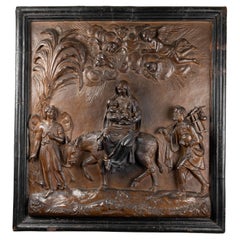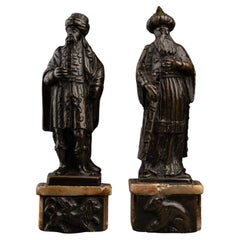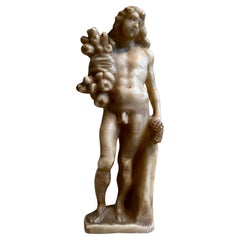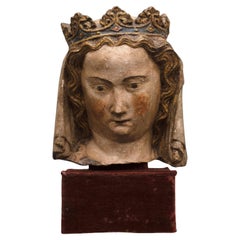Want more images or videos?
Request additional images or videos from the seller
1 of 6
Carved Arm Reliquary, Venice, First Half of, 17th Century
$8,371.78List Price
About the Item
- Dimensions:Height: 23.23 in (59 cm)Diameter: 5.12 in (13 cm)
- Style:Baroque (Of the Period)
- Materials and Techniques:
- Place of Origin:
- Period:
- Date of Manufacture:17th Century
- Condition:Repaired: One finger has been reattached. Wear consistent with age and use.
- Seller Location:Bruxelles, BE
- Reference Number:1stDibs: LU6666233769642
About the Seller
5.0
Vetted Professional Seller
Every seller passes strict standards for authenticity and reliability
1stDibs seller since 2022
15 sales on 1stDibs
Authenticity Guarantee
In the unlikely event there’s an issue with an item’s authenticity, contact us within 1 year for a full refund. DetailsMoney-Back Guarantee
If your item is not as described, is damaged in transit, or does not arrive, contact us within 7 days for a full refund. Details24-Hour Cancellation
You have a 24-hour grace period in which to reconsider your purchase, with no questions asked.Vetted Professional Sellers
Our world-class sellers must adhere to strict standards for service and quality, maintaining the integrity of our listings.Price-Match Guarantee
If you find that a seller listed the same item for a lower price elsewhere, we’ll match it.Trusted Global Delivery
Our best-in-class carrier network provides specialized shipping options worldwide, including custom delivery.You May Also Like
Pair of 17th Century Italian Reliquary Busts
Located in Lincoln, GB
Pair of painted carved wood and gesso, Italian, late 17th century, reliquary busts.
Category
Antique Late 17th Century Italian Busts
Materials
Wood
17th-18th Century Italian Wooden Reliquary Bust of a Madonna
Located in Buisson, FR
Spectacular and very decorative piece. Large carved wooden reliquary bust of a Madonna. Beautiful traces of color. Small losses and without the relics. Silver/silvered central piece ...
Category
Antique 17th Century Italian Baroque Busts
Materials
Wood
$4,724 Sale Price
41% Off
H 16.93 in W 13.39 in D 7.88 in
Rare Venice Door Knocker Bronze, 17th Century
Located in Epfach, DE
A rare and very charming door knocker, Venice, 17th century
in bronze with special patina.
Category
Antique Late 17th Century Italian Baroque Figurative Sculptures
Materials
Bronze
17th Century Carved Figure of a Saint
Located in Gloucestershire, GB
Mid 17th century Northern European carved figure of a saint.
This striking statue depicts a saint who is dressed in robes, whilst holding his hand over his heart. This figure is freestanding and is stood within a leaning position which makes him stand out.
It has been beautifully carved from oak and has remnants of its original paintwork.
Likely to have stood within a church for many years and would have been removed due to renovation reasons.
This historical figure...
Category
Antique 17th Century German Gothic Figurative Sculptures
Materials
Oak, Paint
Antique Venetian Limestone Head of Scaramouch Venice Early 17th century
Located in Doha, QA
This incredible one of a kind hand crafted limestone Head of Commedia dell’arte character Scaramouche was found many years ago by an archeologist in Venice Plaza San Polo by Rialto Bridge. The head is masterfully and very detailed hand crafted out of limestone and placed on a pedestal with an ivory marble base.
A truly unique part of Venetian History and an important figure in the world famous Italian Commedia...
Category
Antique 17th Century Italian Baroque Busts
Materials
Limestone, Marble
$1,129
Free Shipping
H 7.88 in W 2.76 in D 2.76 in
Late 17th Century Reliquary Bust of a Bishop in Gilded Wood
Located in NICE, FR
This exceptionally majestic and unique reliquary bust carved in gilded wood represents a bishop adorned in golden robes. The torso is draped in a toga revealing a round cavity that o...
Category
Antique Late 17th Century French Louis XVI Busts
Materials
Wood
17th Century Carved Applewood Sculpture of the Lady of Sorrow
Located in Hoddesdon, GB
A 17th-century carved applewood sculpture of the Lady of Sorrow is a representation often associated with Catholic icons, particularly depicting the Virg...
Category
Antique 17th Century French Baroque Figurative Sculptures
Materials
Wood
17th Century Italian Painting with Angel Wing Frame and 17th Century Arm
By Interi
Located in Dublin, Dalkey
Titled "Vulnerabilita" by Jean O'Reilly Barlow
A 17th century Italian painting with a hand-carved 17th century arm. It is framed with 17...
Category
Antique 17th Century Italian Rococo Paintings
Materials
Quartz, Rock Crystal, Iron
$7,000
H 25 in W 15 in D 12.5 in
17th Century 'Baroque' Pair of Italian Carved and Polychromed Sculptures
Located in North Miami, FL
17th Century (Baroque) pair of Italian carved and polychromed figures. Each statue is holding a torchere and are mounted on their original turned wooden faux marble column.
Category
Antique 17th Century Italian Baroque Figurative Sculptures
Materials
Wood, Paint
$15,960 Sale Price / set
20% Off
H 70 in W 20 in D 13.5 in
Mid-17th Century French Carved Walnut Bust of Saint Paul
Located in Dallas, TX
Carved in France in the 17th century, this commanding walnut bust likely represents Saint Paul the Apostle, depicted with dramatic realism and spiritual gravity. The figure features ...
Category
Antique Mid-17th Century French Baroque Busts
Materials
Walnut
More From This Seller
View AllLarge Terracotta Relief - Lombardy, First Half of 17th Century
Located in Bruxelles, BE
Large Terracotta relief of the flight into Egypt
Lombardy, first half of 17th century
Painted terracotta
91 x 85 x 11,5 cm
This event in the early life of Christ is recounted i...
Category
Antique 17th Century Italian Baroque Figurative Sculptures
Materials
Terracotta
$62,190 Sale Price
20% Off
Two rare Figures in Turkish Attire - Venice, early 17th century
Located in Bruxelles, BE
Rare Bronzes Depicting two Figures in Turkish Attire
Possibly Suleiman the Magnificent at two different ages
bronzes, alabaster bases
Venice, early 17th century
19,5 x 6 x 5 cm
These two rare bronze statuettes represent two figures dressed in elaborate "Turkish" attire. They are mounted on alabaster bases with bronze reliefs—one featuring the winged lion of Venice, and the other possibly symbolizing Turkey with a wolf depiction.
One figure wears a grand külah, a spherical turban with a cone top, signifying royal authority, while the other has a wrapped turban, denoting rank and religious identity. Their garments are richly detailed with intricate engravings, suggesting luxurious fabrics of the Ottoman court.
The statuettes may represent Suleiman the Magnificent at two different stages of life, as both young and old. The sultan depicted alongside the winged lion corresponds to a description from a Venetian delegate in 1534, when Suleiman was 43. At that time, he had conquered Iraq from the Safavids and achieved a decisive victory over the Papal fleet at the Battle of Preveza. He was described as having large eyes, an aquiline nose, and long red mustaches—traits visible in Cristofano dell'Altissimo’s portrait of Suleiman in the Uffizi Gallery in Florence.
Unlike Mehmed II, who commissioned portraits by European artists for diplomatic purposes, Suleiman did not directly order such representations. Instead, his likeness spread through works by artists like Albrecht Dürer, based on sketches made by diplomats. Following his capture of Belgrade in 1521, his victory over Hungary in 1526, and his siege of Vienna...
Category
Antique 17th Century Italian Renaissance Figurative Sculptures
Materials
Alabaster, Bronze
Bacchus - Southern Italy, late 17th century
Located in Bruxelles, BE
Bacchus
Southern Italy, late 17th century
Alabaster Sculpture
H: 20 cm
A finely carved 17th-century alabaster sculpture of a naked Bacchus. This Italian alabaster figure depicts ...
Category
Antique 17th Century Italian Baroque Figurative Sculptures
Materials
Alabaster
Head of a crowned Virgin - Lorraine, first half of 14th century
Located in Bruxelles, BE
Head of a crowned Virgin
Lorraine, first half of 14th century.
H26 x 14 x 14 cm
Provenance :
- Private Collection, Paris France (1960)
Private Collection Tuscany, Italy (1980)
Ex...
Category
Antique 15th Century and Earlier French Gothic Figurative Sculptures
Materials
Limestone
Cerberus, Italy, 17th Century
Located in Bruxelles, BE
Cerberus
Black painted stone
Italy, 17th century
Measures: 80 x 69 x 36cm
(one head missing)
Cerberus, cruel monster, fierce and strange,
Through his wide threefold throat barks as a dog
Over the multitude immers'd beneath.
His eyes glare crimson, black his unctuous beard,
His belly large, and claw'd the hands, with which
He tears the spirits, flays them, and their limbs
Piecemeal disparts (Dante, Inferno, Canto VI).
Cerberus figure seated, in his role of ferocious guardian of the underworld; he shows a nervous musculature, an adherent skin which reveals the ribs, long and robust limbs; his heads are broad and the eyes set well apart.
Painted in black to amplify his menacing look, the infernal guardian is depicted with his famous attributes, writhing his heads, growling and barking furiously.
Cerberus, in Greek mythology, was the monstrous watchdog of the underworld – also known as the “hound of Hades” – preventing the dead from leaving, and making sure that those who entered never left.
A child of Typhon and Echidna, he was part of a monstrous family, which included Orthus, the Lernaean Hydra, and the Chimaera as well. Only on three occasions Cerberus was tricked by visitors of Hades: Heracles did it with his strength, Orpheus with his music.
In "The Inferno", Dante places Cerberus as the guardian of the third circle of Hell. With his three mouths, Dante saw Cerberus as a beast that was synonymous with the sin of Gluttony. Virgil gets past the monster by throwing mud in his three mouths, temporarily choking him.
Very rare are the representations of Cerberus in ancient statuary...
Category
Antique 17th Century Italian Renaissance Figurative Sculptures
Materials
Stone
$19,733 Sale Price
25% Off
Bronze salamander - 17th century
Located in Bruxelles, BE
Bronze salamander
Italy, 17th century
Patinated bronze
4 x 17 x 10 cm
This finely cast bronze salamander exemplifies the 17th-century fascination with naturalistic forms and animal ...
Category
Antique 17th Century Italian Renaissance Animal Sculptures
Materials
Bronze



